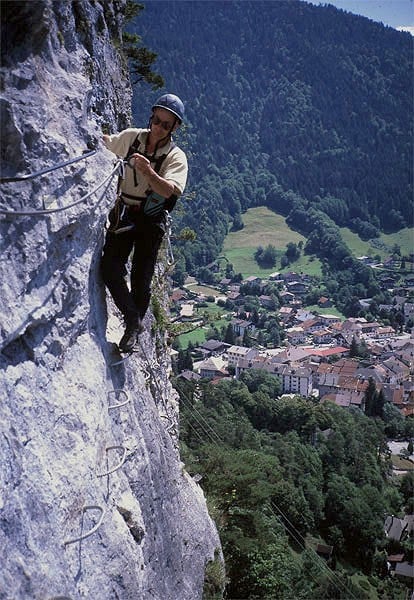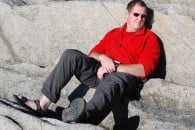The summer did not turn out quite as it was supposed to - central Switzerland was damp and the pencilled-in plan of cruising up giant granite classics was replaced, at least in the short-term, by grabbing short routes on the limestone around Meiringen or the gneiss roadside cliffs of the Susten Pass, .... and then things got worse. The heaviest rains for a generation hit Austria and Germany and the Alps were caught in the edge of the fallout, so we adjourned to the Jura - well away from the big hills. Even here it was wet enough to force us to dump the soggy camping gear for a few days and move into a rented chalet - to escape damp bedding and the thrumming of rain on canvas was both a relief and a luxury. We managed to grab the odd route on the rapidly drying limestone cliffs that speckle the valley sides as and when the weather allowed but even here it was a continuous tussle with the elements.
Then a glimpse at a newspaper forecast suggested that the worst of the weather was drifting north and east, so we headed south and west as fast as the speed limit would allow. By the time we reached Lake Annecy things had returned pretty much to normal with blue skies and warm sunshine and we set about drying out and getting the route tally back into reasonable figures. We organised camp at Thônes, a beautiful little town set in a deep wooded valley and surrounded by high limestone hills. The recently acquired Jingo Wobbly guide, Euro Sport Vertical indicated that there were several high quality cliffs within easy striking distance of the town and pre-eminent amongst these appeared to be the crags at the Col de Colombière, supposedly home to sixty routes up to three pitches long and south facing, so the next morning we rolled up and the guide proved to be spot on. Surprisingly we struggled to find parking amongst the crowds of day-trippers and walkers who are always attracted to these high places. The sky was dotted with brightly coloured parapents spiralling high above on the thermals, cyclists poured over the col and the whole place had a real holiday atmosphere – as so often happens on an extended trip we had forgotten it was the weekend! The walk up to the cliff follows a well marked (and equally well-signed) track and takes a steady 40 minutes, zigzagging steadily with the views to the south and east improving all the time as the jagged snow capped peaks of the Dents du Midi appear above the enclosing ridges. As the crag came into close view it was obvious that the rock here is something really special, perfect sheets of pale blue grey limestone creased vertically by lines of deeply incised 'canalures'. These deep twisting grooves braided in the rock, have been worn over millennia by running water as it slowly dissolved the solid rock. These features are virtually unknown in the UK but are relatively common over on the Continent, especially the high and exposed cliffs that bake in the summer and freeze in the winter.
At the right edge of the cliff, at the point where the approach path arrives is a well designed flat area, always popular at least in part because it is backed by a fine slab with half a dozen lower grade classics, and also because it makes a great place for lunch. The usual warm-up here is the single pitch of Litteul Kevin (F5b) a perfect introduction to the rock and the style of climbing. Getting up the canalures requires a unique technique, and is most easily achieved by wide bridging and laying-away off the rounded edges with the hands. Friction in the grooves is generally good, though climbing them 'face on' can be a harrowing form of progress, sustained and precarious, with the prospect of a fall down the sharp razors edges between the canalures being too terrifying to consider. I for one found the climbing hurt my broad English feet, though it made a change from the more usual scenario of sore fingers and pumped forearms when climbing steep foreign limestone. Also at this end of the cliff there are a couple of longer routes including the classics of Les Forcats (F5c+, 5c) and the superb 50m pitch of Cactus (F5c), both on rock as good as it gets.
Running leftwards the cliff gets steeper and more spectacular though the rock remains peerless throughout. Quality classics come thick and fast, try the juggy Merci Florent (3 pitches, all F5c), Bele du Matin, Chagrin (F6b, 6b) or the bulging blue-grey streak tackled head on by Pourquio Tant de Haine? (F6c+). Those who don't like pussyfooting about on low-angled rock should make straight for this central section where a good time is assured. The central and stunning looking line of Fils du Ciel (F7b) gets 12 stars in the guide (on a scale of 4!) and the book is quick to point out that this is not a typo!
On the far left the cliff drops back in angle once more and again is home some lower and middle grade classics, pre-eminent amongst which is the two pitch La Fissure a Nounours (F5a, 5b). The initial pitch follows what is probably the deepest canalure on the whole cliff, so incised in places that it is possible to get a whole leg inside it. The second pitch tiptoes across a fine delicate slab side-stepping steeper rock then pulling back right to finish up a juggy and exposed rib. We spent a couple of long and busy days here though in reality it would have been possible to spend the best part of a week and still have routes left to go at.

For something a little less serious the popular crag of La Culaz is worth a visit, although only 20 or so metres high it is home to almost 50 routes, all on great rock and many at a reasonable grade, a fine spot to be inculcated into the mysteries of sport climbing. It is popular with families and guides introducing folks to this great game of ours.
Another attraction in the Thônes area is a series of recently installed and extensive Via Ferrati, designed at least in part to attract people into the area for a little exposed 'fun'. The work involved in setting up these is impressive indeed, drilling hundreds of holes and wrestling the thick steel cables into place high on the cliff face must have been a gargantuan task. Unlike the Ferrati of the eastern Alps which were built specifically to access the peaks and thus look for lines of least resistance, these have been designed simply to be spectacular and challenging. The one behind Thônes is certainly both of these, and it starts only 10 minutes from the town. Emerging from the trees, the first obstacle is a spectacular wire walkway above a very big drop - doubtless there to sort the serious candidates from the merely inquisitive. After this it forges up more than a thousand feet of impressive territory weaving round ribs, pulling over bulges and linking narrow ledges. The more outstanding features are named with neatly engraved plaques bolted to the wall so you always know exactly where you are. Eventually after a couple of hours of superbly exposed exercise, the iron way leads to a choice of exits depending on your fitness and state of mind. A long ledge running rightwards is the easy escape out onto the shoulder of the hill, whereas a more direct version is a long ladder that leans out over the void, climbed on the easier angled, but wildly exposed inside face. The final choice is the Direct Finish, described on a plaque at its foot 'as only suitable for experienced climbers'; that sounded like to big a challenge to miss. A series of closely spaced rungs lead up the overhanging wall and over a substantial roof, all set above the steepest and most exposed section of the cliff. Not being the strongest of souls (or at least being just a little gravitationally challenged) I progressed using a couple of short cow's-tail leapfrogging them between the rungs, thankful for an aid climbing apprenticeship way back in my youth! It was only later that we discovered this particular Via Ferrata is regarded as one of the three most taxing in the whole Alps. In the strictest sense it cannot really be considered as climbing but undoubtedly they make a spectacular change from regular rocking and for anyone who is happy moving over exposed ground the positions reached can especially be thrilling. I must admit we were almost tempted to go and do another one!
The cliffs at Thônes are accessible all year round and the area is a worthwhile destination if you are after climbing on a variety of venues in a magnificent setting. The place can be reached in less than an hour from Chamonix and is worth pencilling in for those days when the clag is down on the big hills, but a glimmer of sunshine can be seen down at the end of the valley – go to it and sample what just might be the best limestone in the world!
Fact File
Thônes lies at an altitude of 3000 feet and the cliffs described here are up at 6/7000 feet above sea level and all face south. They are high enough to be climbable in high summer, yet their aspect makes them a good venue of sunny winter days. All the routes described are fully equipped. The guide to the area Escalades dans le Massif des Aravis is available from the book shops in Thônes for €14
Visit the Paul Braithwaite Climbing shop website for more information on Via Ferrata including a brief technical introduction by shop owner Simon Taylor and a further description of the Via Ferrata de la Roche a Agathe described by Chris.
Visit Chris Cragg's website for more of his photography and details of his guidebooks.
advert() ?>



Comments